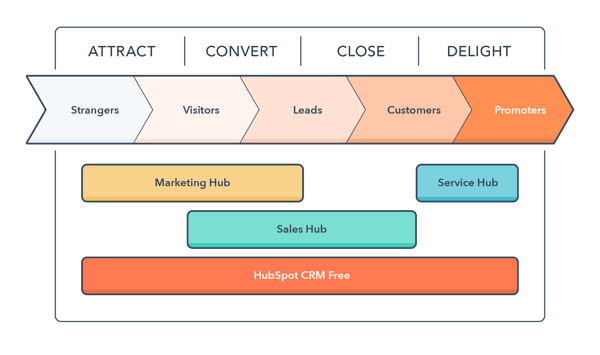Welcome to Step 08. Want to jump back to our full 11 step Business Growth process?
Why? 72% of businesses are more likely to buy from an expert. Content helps people solve problems. The more education you can provide your prospects and customers before they talk to or meet with sales, the more qualified they’ll be when they get there. If your marketing team hasn’t been focusing on driving people toward purchasing your products or services, it’s time for them to rethink their priorities. Content aligned to sales will help you:
 As a HubSpot Certified Partner, we use content every day to help our Automotive clients to generate sales. For BTB Exhausts, we used a blog post about manifold design, shared it on LinkedIn as a direct message to car restoration people, and that secured sales of exhaust systems with the special vehicle department in a major OEM as well as specialist restoration companies.
As a HubSpot Certified Partner, we use content every day to help our Automotive clients to generate sales. For BTB Exhausts, we used a blog post about manifold design, shared it on LinkedIn as a direct message to car restoration people, and that secured sales of exhaust systems with the special vehicle department in a major OEM as well as specialist restoration companies.
We see content as Attention = Value! And a way to stop sending the same generic sales message and start using content to educate.
Part of our collaborative approach to business growth Why is to have sales and marketing working together on content creation. Why?
And to align this to your content to how your Ideal customers purchase, we use the Inbound Marketing Methodology:

If prospects and customers consume more content before they contact you with a sales enquiry then you have a better chance to sell. Instead of sales answering the same questions over and over again, use content to answer and nurture your Ideal customers to create better leads for sales = more time selling and less time explaining!
We start with content at the Bottom of the Funnel as this talks to people that are at the Decision stage and are ready to buy. This is where your Revenue team (sales and marketing) have to be working together. Why? Even if sales content is easily accessible, your sales team won’t use it if it isn’t part of their process.
We start by asking your salespeople to look through their sent emails to see
Then we run a content audit - we’ll cover this when we start working together then every 6-months:
The Ideal customer research helps us understand your Ideal customers. Then it’s about combining that knowledge with content at different stages of their buying journey to make sure they’re nurtured so when they contact sales, they understand the value of your products and services.
This table is a good example of the stages a buyer goes through and the sort of content and terms that are helpful to nurture buyers from when they start their research and education through to when they make a decision on what to purchase.
| Awareness | Consideration | Decision | |
| User behaviour | Have realized and expressed symptoms of a potential problem or opportunity. | Have clearly defined and given a name to their problem or opportunity. | Have defined their solution strategy, method, or approach. |
| Research & info needs | Research focused on vendor neutral 3rd party information around identifying problems or symptoms. | Committed to researching and understanding all of the available methods to solving their defined problem or opportunity. |
Researching supporting documentation, data, benchmarks or endorsements to make or recommend a final decision. Content that shows it’s easy to move from their current supplier to you. |
| Content types for marketing to use (and sales to access) |
Analyst reports |
Comparison white papers Expert Guides Live interactions Webcast/podcast/video Email marketing templates |
Vendor comparisons |
| Content for sales to use |
Content created by marketing. Outside of HubSpot: LinkedIn Sequences and Phrases Inside of HubSpot: |
Content created by marketing. Outside of HubSpot: LinkedIn Sequences and Phrases Inside of HubSpot: |
Content created by marketing. Outside of HubSpot: Inside of HubSpot: |
| Key terms | Troubleshoot Issue Resolve Risks Upgrade Improve Optimise Prevent |
Solution Provider Service Supplier Tool Device Software Appliance |
Compare |
| Example | I'm developing a new vehicle for road and motorsport. I've done this before I usually have problems with supply chain or finding innovative product to beat the competition. | I'll check with my regular suppliers as I've used them for some time. I also did some research online and by speaking to my peers. They gave me details of some new suppliers that were publishing whitepapers and look to be knowledge on the topics I need support with. |
I've shortlisted the suppliers I want to work with. I decided on the criteria that's needed for this project with regards to specification, delivery requirements, and budget. I know who I'm going with. It wasn't the lowest cost option but they showed the right capabilities and reliability. |
Sitting down to write content does take time; however, as it does need to come from you, we take a different approach to content creation so it doesn’t consume your time. How?
Working from your Ideal customer research and your content schedule, we’ll:
We see this as a combination of email newsletters typically sent monthly and emails used within workflows for lead nurturing. The two require a different approach and style so we follow the CAT approach to email marketing to get the best success:
When we consider the right audience for the right content, we’ll take a look at your contacts Lifecycle stage in HubSpot CRM as this is a good indication of the content that will be most relevant to educate and nurture them. We consider the following to be good types of content at each stage of your Ideal customers buying journey from when they’re just realising the have a challenge or problem (Awareness), when they’re starting to research solutions (Consideration), and when they’re deciding who to choose (Decision):
Once content is complete, we follow the agile approach of 1) theory, 2) action, 3) outcome, 4) learn...

We use cookies to provide the services and features offered on our website, and to improve our user experience
Cookies are small files or other pieces of data which are downloaded or stored on your computer or other device, that can be tied to information about your use of our website (including certain third party services and features offered as part of our website)
By clicking "I Accept" you agree to such use of cookies, unless you later decide to disable them
Please note that if you delete or disable our cookies you may experience interruptions or limited functionality in certain areas of the website.